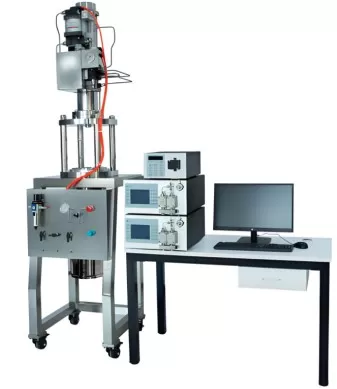Analytical vs. Semi-Preparative vs. Preparative HPLC: A Strategic Guide to Precision, Scale, and Efficiency
In the fields of drug development, natural product isolation, and biomolecule purification, High-Performance Liquid Chromatography (HPLC) stands as an indispensable tool. However, choosing between analytical, semi-preparative, and preparative HPLC systems can be challenging without a clear understanding of their distinct roles. This article delves into the technical parameters, application scenarios, and selection strategies for these three HPLC variants, empowering researchers to optimize purification efficiency and cost-effectiveness.
Defining the Differences: From Traditional Classifications to Modern Applications
Traditionally, HPLC systems were categorized based on column dimensions or flow rates. Modern practices, however, emphasize application-specific objectives:
Analytical HPLC: Focuses on qualitative and quantitative analysis, identifying the presence and concentration of target compounds (e.g., drug impurity profiling, metabolite identification).
- Key Specifications: Column inner diameter (2.1–4.6 mm), flow rate (0.2–2 mL/min), and sample loading (µg range).
- Example: Using an Agilent 1260 Infinity II system with a ZORBAX analytical column to detect trace metabolites in pharmacokinetic studies.
Semi-Preparative HPLC: Balances small-scale purification with cost efficiency, ideal for candidate compounds screening or process optimization.
- Key Specifications: Sample loading (mg–g range), flow rate (5–50 mL/min), and columns with 10–25 mm inner diameters.
- Example: Purification of ¹¹C-labeled PET probes using a 10 mm C18 column at 4 mL/min to achieve high purity (>95%) with minimal solvent consumption.

Semi-Preparative HPLC System
Preparative HPLC: Designed for industrial-scale purification, prioritizing yield (>90%) and purity (>98%) for bioactive molecules like peptides or antibodies.
- Key Specifications: Large columns (30–100 mm inner diameter), high flow rates (50–1000+ mL/min), and sample loads (g–kg range).
- Example: Industrial extraction of ginsenosides using a 50 mm column under medium-pressure conditions, achieving 100 g-scale processing per run.
Critical Distinctions:
- Column Selection: Analytical systems use high-efficiency columns (3–5 µm particles), while preparative systems employ robust 10 µm particles to withstand high pressures.
- Fraction Collection: Analytical systems focus on detection, whereas preparative systems rely on automated fraction collectors for dynamic peak-based collection.
Technical Parameters: Performance Boundaries and Optimization Strategies
|
Type |
Column Inner Diameter (mm) |
Flow Rate (mL/min) |
Sample Load |
Primary Goal |
|
Analytical |
2.1–4.6 |
0.1–5 |
µg range |
Resolution >99% |
|
Semi-Preparative |
10–25 |
5–50 |
mg–g range |
Purity >95% + Yield optimization |
|
Preparative |
30–100 |
50–1000+ |
g–100g range |
Maximized throughput |
Applications and Case Studies
1) Analytical HPLC in Action
- Drug Metabolite Profiling: A combination of dual aqueous phase flotation and analytical HPLC rapidly identifies flavonoid compounds in ‘Solanum rostratum’ extracts.
- Quality Control: Detecting residual solvents in APIs (active pharmaceutical ingredients) with sub-ppm sensitivity.
2) Semi-Preparative HPLC for Process Development
- Peptide Intermediate Purification: MDM2 protein purification achieved 14 mg yields using a semi-preparative C18 column under 60°C gradient elution.
- Radiopharmaceuticals: Efficient purification of short-lived isotopes (e.g., ¹⁸F-labeled tracers) for PET imaging.
3) Preparative HPLC in Industrial Settings
- Biopharmaceuticals: Large-scale purification of monoclonal antibodies (mAbs) for clinical use, ensuring >99% purity.
- Natural Products: Industrial isolation of paclitaxel from ‘Taxus’ bark, achieving kilogram-scale production annually.
As advancements in biopharmaceuticals and personalized therapies drive demand for clinical-grade drug production, preparative HPLC has become indispensable for large-scale manufacturing, ensuring high-purity yields of biologics like monoclonal antibodies. Simultaneously, semi-preparative HPLC systems are evolving to support high-throughput screening in early-stage drug discovery, enabling efficient purification of candidate compounds while balancing cost and scalability. Emerging trends such as automation (via robotic liquid handlers), green chemistry (solvent recycling systems), and AI-driven optimization (machine learning for gradient prediction) are reshaping the field, enhancing precision and sustainability. Analytical HPLC remains critical for ultra-precise qualitative and quantitative analysis, though limited in scalability, while semi-preparative systems bridge lab-scale R&D to pilot production, and preparative HPLC serves as the cornerstone of industrial biomanufacturing. Together, these technologies form a cohesive pipeline from discovery to commercialization, addressing diverse needs across the pharmaceutical lifecycle.
References
Allwood JW, Goodacre R. An introduction to liquid chromatography-mass spectrometry instrumentation applied in plant metabolomic analyses. Phytochem Anal. 2010 Jan-Feb;21(1):33-47. doi: 10.1002/pca.1187.
de Souza ID, Queiroz MEC. Advances in sample preparation and HPLC-MS/MS methods for determining amyloid-β peptide in biological samples: a review. Anal Bioanal Chem. 2023 Jul;415(18):4003-4021. doi: 10.1007/s00216-023-04631-9.
Next-Generation Omics Solutions:
Proteomics & Metabolomics
Ready to get started? Submit your inquiry or contact us at support-global@metwarebio.com.


